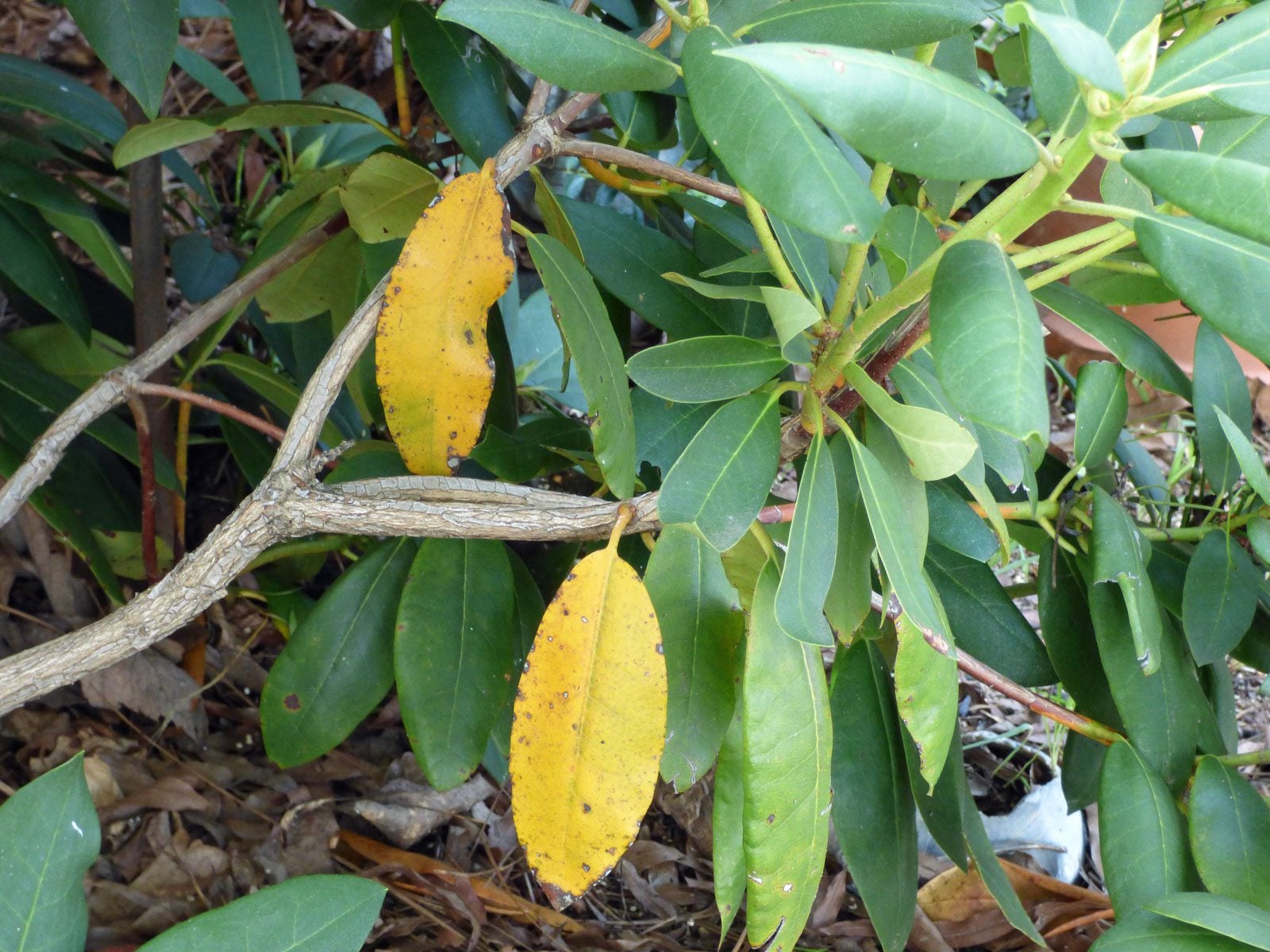I studied horticultural science and am, naturally, a passionate hobby gardener. I harvested my first watermelons at the age of 7. At the moment, I am particularly interested in topics related to the interaction of plants with other living beings and the environment. My favourite fruit: Definitely avocados. My favourite vegetable: Actually all veg except Brussels sprouts
Yellow leaves on rhododendrons indicate an iron deficiency. Azaleas too often suffer from so-called chlorosis due to an incorrect pH.
Rhododendrons, which are bog plants, are particularly susceptible to chlorosis. Chlorosis on rhododendrons is often due to indirect iron deficiency. As a result, not enough of the green pigment chlorophyll can be produced. Without this pigment, however, photosynthesis is no longer possible. This, along with unsightly leaves, is the main reason why a bleached appearance should be treated. Find out what to do if your rhododendron has yellow leaves in this article.
Rhododendrons are popular broadleaf evergreen shrubs that produce beautiful blooms in spring. However, a common issue that rhododendron owners face is yellowing leaves. There are several potential causes for rhododendron leaves turning yellow. By understanding these causes, you can take the right steps to restore the health and color of your rhododendron.
Common Causes of Yellow Rhododendron Leaves
Here are some of the most common reasons rhododendron leaves turn yellow
-
Improper soil pH Rhododendrons prefer acidic soil with a pH between 4.5-5.5. Soil that is too alkaline can prevent the plant from absorbing key nutrients like iron, leading to yellow leaves. This often shows up first in new growth.
-
Lack of iron: Even if soil pH is ideal, a deficiency of iron can still cause yellowing. Iron aids chlorophyll production.
-
Nitrogen deficiency Insufficient nitrogen leads to overall pale leaves and stunted growth, This typically starts on older leaves first
-
Pests: Common rhododendron pests like lace bugs and vine weevils can cause mottled yellow spots or notches in leaves. Check undersides for evidence of bugs.
-
Root damage: If roots are damaged by animals, fungi, or overly wet soil, the plant cannot take up water and nutrients well. This leads to yellowing.
-
Incorrect planting depth: If planted too deeply, poor drainage and root rot can occur, turning leaves yellow.
-
Drought stress: Lack of water during hot, dry periods stresses the plant, causing leaves to yellow and drop.
-
Sun scorch: Too much direct sun burns leaves, which then turn yellow or brown. Rhododendrons prefer shade.
Solutions for Yellow Rhododendron Leaves
If your rhododendron shows signs of yellowing leaves, here are some tips to help nurse it back to health:
-
Test soil pH and adjust to between 4.5-5.5 using aluminum sulfate or elemental sulfur.
-
Apply chelated iron supplements or iron-rich fertilizers. Foliar sprays work quickly.
-
Use nitrogen-rich fertilizer like blood meal or cottonseed meal. Liquid seaweed also supplies fast nitrogen.
-
Inspect closely for pests like lace bugs and treat accordingly. Spray horticultural oils or neem oil.
-
Improve drainage and aerate soil if leaves are yellowing from wet roots.
-
Replant at proper depth with top of root ball even with soil surface.
-
Water deeply during drought and mulch to conserve moisture.
-
Move to a shadier spot if planted in full sun. Filtered sunlight is better.
-
Remove dead leaves and branches. Prune damaged roots and rejuvenate with new soil.
By pinpointing the cause and taking appropriate corrective measures, you can often revive a yellowing rhododendron. Be patient, as it takes time for improvements to show. With proper care, your rhododendron’s leaves should turn back to a healthy green.

How to recognise chlorosis
The symptoms of chlorosis are very easy to recognise, especially in rhododendrons. If the leaves become yellowish, with the leaf veins often remaining green, chlorosis is present. As already mentioned above, an iron deficiency is responsible for this, although it is not really an iron deficiency at all. This is because most soils contain enough iron, but above a certain pH rhododendrons find it very difficult to absorb it.
You want to know who’s behind Plantura?


I studied horticultural science and am, naturally, a passionate hobby gardener. I harvested my first watermelons at the age of 7. At the moment, I am particularly interested in topics related to the interaction of plants with other living beings and the environment. My favourite fruit: Definitely avocados. My favourite vegetable: Actually all veg except Brussels sprouts
Yellow leaves on rhododendrons indicate an iron deficiency. Azaleas too often suffer from so-called chlorosis due to an incorrect pH.

Rhododendrons, which are bog plants, are particularly susceptible to chlorosis. Chlorosis on rhododendrons is often due to indirect iron deficiency. As a result, not enough of the green pigment chlorophyll can be produced. Without this pigment, however, photosynthesis is no longer possible. This, along with unsightly leaves, is the main reason why a bleached appearance should be treated. Find out what to do if your rhododendron has yellow leaves in this article.
RhodoDirect Explains Rhododendron Leaf Shedding – Unraveling the Mystery of Yellowing Leaves
FAQ
How do you treat yellow leaves on rhododendrons?
When lime hating plants start to display yellowing leaves Vitax Seaweed plus Sequestered Iron applied as a drench over the foliage and the ground around the plant will often help to restore the foliage. Seaweed is a growth stimulant and the sequestered iron supplies the nutrient in just the way the plant needs it.
What does an overwatered rhododendron look like?
An overwatered rhododendron typically exhibits yellowing leaves, wilting or drooping foliage, and potentially mushy or black roots due to root rot.
What do I do if my plant leaves are turning yellow?
Yellowing leaves on a plant often indicate a problem with watering, light, or nutrients. To address this, first check the soil moisture. If it’s soggy, reduce watering frequency. If it’s dry, increase watering.
